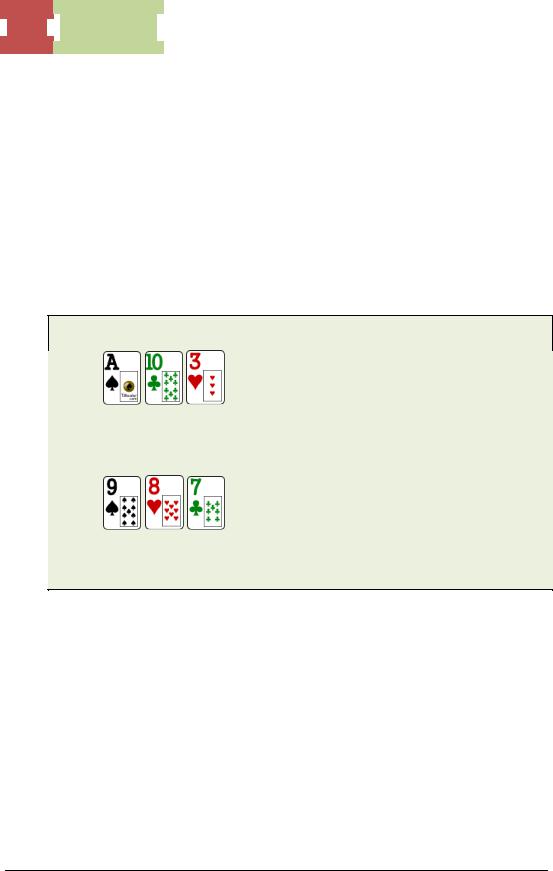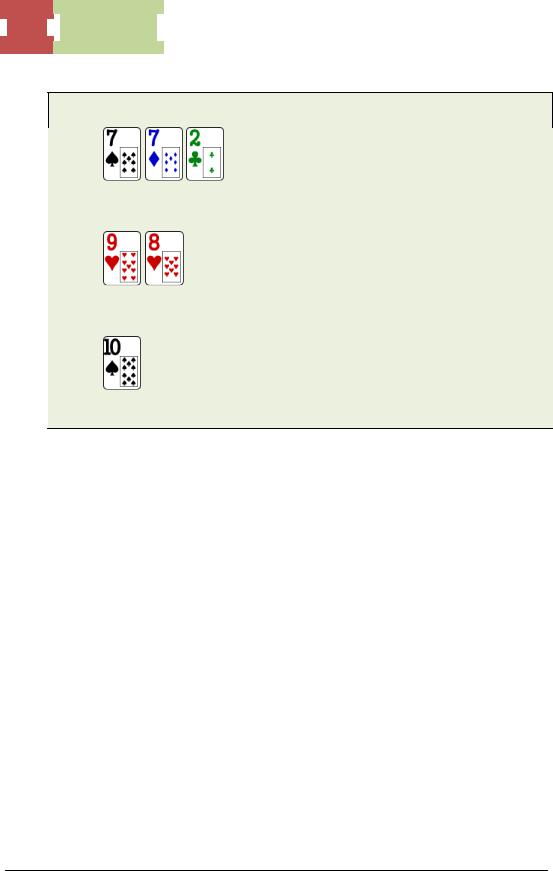
Davis, Aron. The Poker Blueprint
.pdf
 119
119  3-Betting
3-Betting
3-Betting
© 2010 Aaron Davis and Tri Nguyen - All Rights Reserved.
http://www.DailyVariance.com
119

 120
120  3-Betting
3-Betting
“3-bet pots are normal pots on crack.”
The 3-bet is one of the most powerful plays you can have in your arsenal. It is extremely profitable to 3-bet in position, especially from the button. Even if players know you are 3- betting light, it’s tough for most of them to counter it. They usually over-adjust their preflop stacking-off range. This means more money for you since you are risking 10BB to see where you are at and they risk their stack with 99/AJ type hands.
The Fundamentals
In 3-bet pots, due to a smaller stack-to-pot ratio, your post-flop and positional edges decrease in value. This is because if you 3-bet a 30BB short stack, if he calls, he’s going to have a pot-sized stack left on the flop. If he flops anything, then he’s stacking off. Thus, you have little fold equity against opponents with short stacks. If the same player is OOP with 200BB+, then there’s more room for you to maneuver post-flop, meaning more opportunities for you to exploit your positional and skill advantages.
You also have a ton more fold equity with deep stacks because players are much more willing to stack off with 50BB than with 200BB. As a result, you will see more all-in pots when the stacks are 50BB. With 200BB, there is more cautious play because players want to protect their stacks. You probably can’t count more than a handful of times when you’ve seen a good, aggressive player 3-barrel bluff with ace-high and lose 200BB.
Below is a chart that illustrates how different stack sizes affect the game.
 3-bet Pots: Based on Pre-flop Stack Sizes
3-bet Pots: Based on Pre-flop Stack Sizes
|
Characteristics |
|
Short Stack (50BB or |
|
Full Stack (100BB) |
|
Deep Stack (150BB |
|
|
|
|
|
|
||||
|
|
|
less) |
|
|
|
or more) |
|
|
Skill Advantage |
|
Low |
|
Medium |
|
High |
|
|
Positional |
|
Low |
|
Medium |
|
High |
|
|
Advantage |
|
|
|
|
|
|
|
|
Stack-to-pot |
|
Low |
|
Medium |
|
High |
|
|
ratio |
|
|
|
|
|
|
|
|
Showdowns |
|
Very High |
|
Medium |
|
Low |
|
|
Fold Equity |
|
Very Low |
|
Medium |
|
Very High |
|
|
|
|
|
|
|
|
|
|
Creating an aggressive Image
3-betting lightly is an excellent way to create an aggressive image. Players will put you on a wide range of hands and pay you off lighter. Unless they fight back, you will control the
© 2010 Aaron Davis and Tri Nguyen - All Rights Reserved.
http://www.DailyVariance.com
120

 121
121  3-Betting
3-Betting
flow of the game. This allows you to isolate the fish more often, exploiting the regulars’ weakness and playing pots in position. So when is a good time to 3-bet?
You generally want your first 3-bet to be a semi-bluff (hands like J8s, 86s, 75s). This is because people tend to give you more credit for it, and people fear the unknown. If you’ve just sat down at the table and you 3-bet in the first orbit, they don’t know who you are or how you play yet. If you’re a regular, they may have an idea based on previous history, but they won’t know exactly how you’re playing on that day. So they will shy away from doing anything reckless until several orbits later.
After that, keep 3-betting until people give you a reason to stop—by 4-betting you, calling you down lighter, and/or check-raising the flop more. I’d also focus on targeting a weaker player at the table and 3-bet him. If you keep this up, you will end up tilting him and he will be ecstatic to get all-in pre-flop with AQ or 88.
3-bet Stats
Although 3-bet stats are helpful, don’t put too much emphasis on them. They are more reliable if you’re playing heads-up because his stats directly reflect his actions against you. In a 6-max game, if you open from the CO and he 3-bets from the SB, his stats aren’t going to give you an accurate reflection of his 3-betting tendencies. It gives you an overall representation of the game, which can be misleading. He might have recently lost a pot and is now tilting. Or he might have noticed that you folded to a 3-bet an orbit ago, so now he’s doing it lighter. Or he only likes to 3-bet the player to his right and no one else. You just don’t know. It’s more practical and reliable to base your reads on his previous actions. You’ll get better reads on him and really get into his head as a player. Of course, it is important to note that a player with 3-bet stats of 10 percent is looser and more aggressive than a player with 3-bet stats of four percent.
Polarized Range
When you 3-bet, you want to polarize your range. This means you should do it with your strong and weak hands (QQ+, AK, 96s, 76s and 65s). With medium pairs (66-JJ) and medium suited connectors (QTs, T9s), it’s much better to just call because we don’t want to fold to a 4-bet with these hands. They have too much value post-flop to risk folding them. The only exception is if villain is very loose-passive, never 4-bets and tends to check-fold the flop. Then you can 3-bet with 88-JJ for value.
If villain never 4-bets you, then there is less incentive to polarize your range because you will be able to see all flops with your medium-strength hands.
© 2010 Aaron Davis and Tri Nguyen - All Rights Reserved.
http://www.DailyVariance.com
121

 122
122  3-Betting
3-Betting
|
|
|
Weak |
Medium |
Strong |
22-55 |
66-JJ |
QQ+ |
86s, 74s, 65s |
ATs, KTs, QTs, JTs, T9s |
AK |
Calling Station
Against weaker opponents who call 3-bets too often, you should 3-bet more Broadway cards and fewer suited connectors. Your high cards, such as KTo, increase in value because you will be more likely to flop a strong middle or top pair than with a hand like 65s. Furthermore, if villain is calling a lot of 3-bets pre-flop, we don’t have to worry as much about reverse implied odds (he will have tons of hands like K2-K9s). Low suited connectors go down in value because you will rarely flop top pair. They also make smaller flushes than K8s and Q7s. We don’t have to worry about folding to his 4-bets with hands like TT, JJ and AQ, so we can 3-bet more liberally with them.
Another great thing about a calling station is that he plays very straightforwardly after the flop. His goal is to flop big hands and stack off. If he misses, then he folds. He doesn’t realize that you determine the aggression and how much money goes into the pot. With position, you can easily bet or check behind for pot control. Furthermore, he’s making a big mistake against you because your 3-betting range is so wide that he won’t be able to extract value when he flops two pair or better. And those hands don’t come along very often. Even if he does call your flop c-bet, you can still bluff when a scare card comes on the turn or river.
© 2010 Aaron Davis and Tri Nguyen - All Rights Reserved.
http://www.DailyVariance.com
122

 123
123  3-Betting
3-Betting
3-betting as the Aggressor
We will first discuss playing 3-bet pots as the aggressor. You want to do most of your 3- betting in position (from the CO or BTN) because you will have position for the rest of the hand. This allows you to play your hands profitably, as well as widen the range of hands you can 3-bet with.
3-betting against UTG/MP
A player raising from UTG will have a perceived tight range. If you 3-bet him from the button, then you will get a lot of respect. 3-betting the MP is almost the same, as his range will be almost as strong.
Increase your 3-betting range versus UTG. If he starts playing back at you by calling your 3-bets lighter or 4-betting, then slow down. For the most part, however, he will be folding a ton of his holdings and playing back only with JJ+ and AK. This is fine, because it doesn’t happen often. If he calls a lot of your 3-bets and check-folds most flops, then keep doing it. If he starts to call down your multi-barrels, then it’s a good time to narrow your 3- betting range to include more Broadway cards and fewer suited connectors.
3-betting against the Cutoff
Most regulars widen their opening range from the cutoff, so you want to 3-bet the cutoff relentlessly from the button. You’ll have tons of fold equity because: 1) his range is weak, and 2) he doesn’t want to play against you from out of position.
If your opponent has an aggressive 3-betting history, then widen your 3-betting value range because he’s more likely to 4-bet as a bluff. Without history, you can safely fold to a 4-bet even with a hand as strong as AQ. The general strategy is to keep 3-betting him until he starts to fight back. He can fight back by 4-betting pre-flop, check-raising flops, or calling down with marginal holdings.
It is important to realize that there will be times when he shows up with a real hand. If he has folded to your 3-bet five times in a row, and then he 4-bets you, then he has a hand.
There’s nothing embarrassing about getting caught. Phil Ivey gets caught too and he’s the best poker player in the world. If Villain 4-bets, then fold and 3-bet him later.
3-betting from the blinds
You don’t want to 3-bet too often from the blinds. It’s simply not profitable against good, aggressive players in late positions because playing out of position is tough.
© 2010 Aaron Davis and Tri Nguyen - All Rights Reserved.
http://www.DailyVariance.com
123

 124
124  3-Betting
3-Betting
If you do 3-bet from the blinds, then it’s always a good idea to do so with a polarized range. Always 3-bet with QQ-AA and AK. With 99-JJ and AQ, you want to be doing it about half the time. These are good hands, but without an aggressive dynamic, you’re still going to have to fold them to a 4-bet.
3-betting with Deep Stacks
When stacks are 150BB or more, you can 3-bet with many more hands in position, including hands like 96s, J7s, Q7s and K5s. Players play much more straightforward when stacks are deep. Some players will call a lot pre-flop, hoping to flop a strong hand, and will check-fold once they miss. Some players will fold to re-raises pre-flop all the time.
If you’re in the blinds, then you should tighten up your 3-betting range because playing against an aggressive player out of position with lots of money behind is neither profitable nor fun. I know sometimes it looks weak to fold out of position so much. but position is that important and there’s nothing much you can do about it. Fortunately, there are many players out there who love playing out of position and want to show you they can outplay you at a positional disadvantage. Just nod your head in agreement while taking down pots.
3-betting with AQ
Say you and another good player at the table have been clashing. Both of you have 3-bet the other several times already, and have not shown down a hand yet. Finally, you pick up AQ and open-raise from the cutoff. Not surprisingly, he 3-bets you again from the big blind. You could 4-bet him here because his range is somewhat wide, but it’s not the best play because if he shoves all-in, you can’t really call. AQ doesn’t do well against an all-in raise. We’re 38-percent against 88+ and AQ+, and that’s being optimistic, because people will rarely 5-bet shove pre-flop with 88 or AQ.
So, we just call. The plan is to simply shove over his bet on a ton of flops (742 rainbow, T73 rainbow, J55 rainbow, JT5 rainbow, etc.). The drier the board, the stronger your range will appear. If there’s a flush draw possible, he may call you down lighter. The purpose of doing this is to fold out AK on the flop, as well as complete air.
There are some flops you don’t want to raise all-in with. On Axx, just call. On Kxx, just fold. AK, KQ, KJs, or KTs could very well be in his range.
© 2010 Aaron Davis and Tri Nguyen - All Rights Reserved.
http://www.DailyVariance.com
124

 125
125  3-Betting
3-Betting
If you raise all-in on the flop and are called, then you still have about six outs to make the best hand. Against JJ on T66 rainbow, AQ still has 25-percent equity. So if he bet-folds to your shove, then you will win an enormous amount of dead money. Just make sure you don’t raise small and give him a chance to re-bluff. You want to maximize your fold equity by raising him all-in.
You can do this with other Broadway hands such as AJs, ATs, KQ, KJs, KTs, QJs, QTs and JTs.
Important Note: This play can cause you to become spewy if you are mindlessly doing it without logical reasoning and reads. The idea is to wait until the situation presents itself and then apply it. Don’t force the play; let the game come to you. If Villain is weak-passive and he suddenly 3-bets you, chances are, he’s not making a play and is doing it with a premium hand, so fold. This also works best when stacks are around 100BB.
© 2010 Aaron Davis and Tri Nguyen - All Rights Reserved.
http://www.DailyVariance.com
125

 126
126  3-Betting
3-Betting
Playing the Flop
Say you 3-bet an opponent pre-flop and he calls. Now what? How we play postflop depends on various factors, such as his frequency for calling 3-bets out of position, his perception of our range, and of course, board texture.
Your Perceived Range
People will usually put you on AK, high cards, small suited connectors that can’t profitably call a pre-flop raise, or high pocket pairs when you 3-bet before the flop. On the flop, Villain can put us on a different range of hands depending on what we do.
Let’s say the flop is
and we bet this flop. He will fold a large percentage of the time because the board texture hits our perceived range. Had the flop come
it probably wouldn’t hit our range much. So it’s best to check-fold with a hand like AK.
Paired boards
We can also use the flop texture to narrow down our opponent’s hand range. When
Villain calls a c-bet on a paired board, he will have a pocket pair most of the time, and even more often than in single-raised pots. He may sometimes float with ace-high, but that’s not going to happen often in a 3-bet pot. Knowing this, you want to apply serious pressure.
For example:
© 2010 Aaron Davis and Tri Nguyen - All Rights Reserved.
http://www.DailyVariance.com
126

 127
127  3-Betting
3-Betting
A player calls your c-bet on
If an A, K, or Q hits, bet hard again (and fold to a shove). If you have
and the turn is the
you can still bet strong and commit yourself.
Only do this against opponents who are tight or can make a big fold. There will be players who will call the turn again with 88. If he never folds with 88, then you may want to check behind with your 98s or and value bet a river J or 6; bluff the A, K and Q. This allows you to see all five cards with enough money to make a scary river bluff.
Monotone boards
Players generally play two pairs, sets or small flushes very fast on these boards. If you c- bet in a 3-bet pot and he calls, you can safely rule out those hands. There will be so much money out there by then (about 60BB in the pot if he calls) that he would want to get it in right away with his strong hands. Knowing that, you want to be shoving your stack on the turn if you have the nut-flush draw.
Let’s go over a quick hand to demonstrate this concept.
© 2010 Aaron Davis and Tri Nguyen - All Rights Reserved.
http://www.DailyVariance.com
127

 128
128  3-Betting
3-Betting
Say you 3-bet a MP raiser from the BTN with
from the BB and the flop is
You bet and he calls. If the turn is any card other than a J, T or 3, you should bet and call it off.
If you started with 100BB, then you probably have about 70BB left, so it’s the perfect size.
You could fold out Tx with a heart, 99-77 with a heart or a random Kx or Qx with a heart. A strong hand would have raised you all-in on the flop already.
A93-type boards
You want to c-bet almost 100 percent of your 3-betting range here. Even if you have TT-
KK, it’s best to c-bet this OOP more often than not. This can be for thin value if you’ve been 3-betting pre-flop a lot, because he may call you with lower pocket pairs or 9x. More importantly, if you check-call here, you turn your hand face up. We’ve all done this before and we end up in a very difficult spot when villain barrels the turn and the river. We end up leveling ourselves with thoughts like, “He knows I have a weak hand. And he knows I know that, but he’s going to bet anyway because he thinks I’m going to fold. So I call.”
Then you find yourself calling 3 barrels against his AT. The reason why he can 3-barrel with AT is because you would have bet the flop with AJ+. His AT is the same as AK.
Counter
Ace-high flops are great spots to float in position in 3-bet pots. The reason is explained above—villain will c-bet almost 100 percent of his 3-betting range on this flop. We exploit that by floating here. You don’t need a legitimate hand but you should float with a hand that has some equity in the pot in case Villain has a real hand.
If he checks the flop, then just check behind because he probably has some weak made hand like TT-KK that intends to call you down. If he bets the flop, then call.
© 2010 Aaron Davis and Tri Nguyen - All Rights Reserved.
http://www.DailyVariance.com
128
